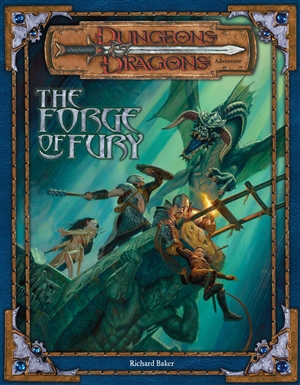 I hated running my first dungeon crawl. I spent hours drawing out maps of each and every single level of the dwarf-hold of Khundrukar on wrapping paper-sized rolls of 1” grid paper, memorized each room to the best of my ability, and then laid them out at my table, prepared to astound my players with an immersive, dungeon-exploration experience.
I hated running my first dungeon crawl. I spent hours drawing out maps of each and every single level of the dwarf-hold of Khundrukar on wrapping paper-sized rolls of 1” grid paper, memorized each room to the best of my ability, and then laid them out at my table, prepared to astound my players with an immersive, dungeon-exploration experience.
It sucked.
Or rather, it would soon suck. My players were all eager to delve into the dungeon and see what riches they could find. They had fun fighting the Great Ulfe, leader of the orc raiders camped out in the stronghold, tricking his lieutenants, befriending his wolves, and figuring out the ancient dwarf-traps left behind by the stronghold’s original inhabitants. It all smacked of an ancient history; a story that had been obscured by time, much like the ancient civilizations of our own world. And I was enjoying the ride along with them. It was damn fun D&D.
But I knew in my heart that it wouldn’t last. As they descended into the glittering, gem-studded caverns beneath, I came to the realization that the mystery the dungeon alluded to didn’t exist. The adventure certainly had a backstory—orcs invaded a mighty dwarf-hold a century ago and all sorts of nasty things have now moved in—and were plenty of interesting creatures and tense encounters, ranging from duergar to ropers to a young black dragon… but there wasn’t any point. There was no mystery of the world to unravel, like in the JRPGs I loved growing up, and there weren’t any fleshed-out characters my players could interact with.
Put another way, the story never developed. The duergar didn’t have a plan to foil; they were just another faction of monsters to kill or ally with. The dragon that lurked beneath the stronghold didn’t want anything except to maintain the status quo of duergar paying it tribute. Ultimately, traveling from an orc-infested fortress to a winding cavern filled with troglodytes didn’t make the dungeon more interesting, it just made the dungeon… more. The dungeon was very good at stringing players along, making them think that there was something more to it all… except there wasn’t. Like a bad, J.J. Abrams-style mystery box. After reaching the duergar stronghold, the players began to understand that there was no deeper meaning. Despite all the fascinating set pieces, I could feel my players losing investment the deeper they got. And feeling your players losing interest in your game burns a DM out quick.
I blamed myself for failing my players and failing myself. I felt I’d done the adventure a disservice; after all, I had called Forge of Fury my favorite adventure for years because of its inspiring locations and individual monsters. It was especially vexing because I consider myself pretty damn good at adapting adventures to suit my storytelling needs. I chopped out the middle third of Princes of the Apocalypse and changed it out with a homemade adventure in the Elemental Plane of Water and a journey to the Waterdeep-equivalent metropolis of my home campaign setting. But even though the whole point of a dungeon crawl is to allow DMs to create stories set within them and “do it yourself,” I couldn’t manage to do it.
Even though dungeons in D&D have a long history of encouraging do-it-yourself attitudes and on-the-fly improvisation, I felt obligated to “play the dungeon right” by following the text of the adventure as closely as possible. I don’t want to make that same mistake with Undermountain, and I don’t want you to, either.
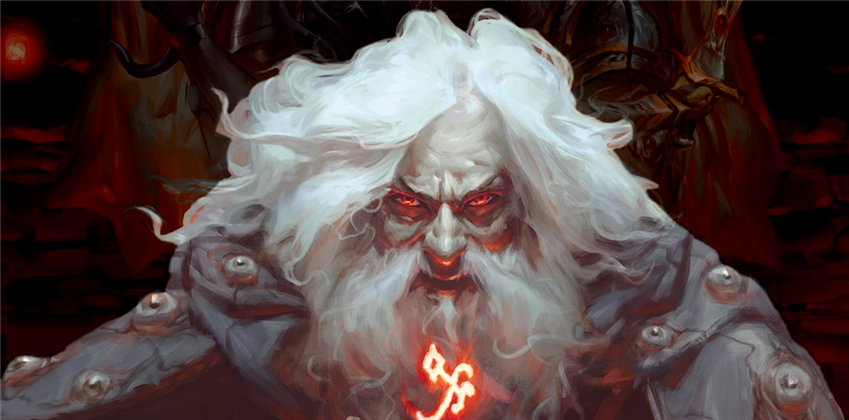
Giving Halaster Depth
In my ill-fated journey through The Forge of Fury, the greatest impediment I found to telling a cohesive story was its NPCs. In a dungeon-focused adventure, most of the text is allocated to describing locations, traps, treasure, and encounters. That makes sense, but it means that most NPCs in dungeon adventures have cardboard-thin personalities. In Forge of Fury, most NPCs’ motivations and backstory were usually summed up in only a sentence (or two, if you’re lucky). I know some DMs feel constrained by overly detailed characters, but I feel the exact opposite; trying to build a cohesive story out of such shallow characters is like putting together a jigsaw puzzle without any pieces. So, how do you tell a story in Undermountain? Create detailed NPCs with motivations, and then play those motivations. It's as "simple" as that.
When given complex and detailed NPCs, it’s much easier for me to take what I want and throw out the rest, rather than build up from nothing. Strahd von Zarovich is the perfect example of a richly detailed NPC becoming the lynchpin for an entire adventure. And even though he’s so thoroughly fleshed-out, Strahd’s personality and desires are easily overhauled by DMs who want something a little different. In a pinch, evocative theming can make up for a lackluster backstory and motivation, such as in the case of the prophets of elemental evil in Princes of the Apocalypse. Halaster Blackcloak, the eponymous Mad Mage, fails to live up to the theming of elemental villains or the rich emotionality of Strahd. Even though five meaty paragraphs are dedicated to Halaster’s and Undermountain’s mysterious origins, they do little to make me care about Halaster as a villain.
Let’s take a close look at all the information Dungeon of the Mad Mage gives us about Halaster Blackcloak, then get creative and mold him into a villain that can serve as the centerpiece for an entire adventure. Halaster’s schemes should set in motion a grand scheme that echoes throughout the dungeon and spurs the characters downward to explore more of the dungeon and eventually find Halaster himself. Ideally, Halaster should be manic and multifaceted, and his motivations should be hard to pin down… but he should have a motivation.
Halaster Blackcloak
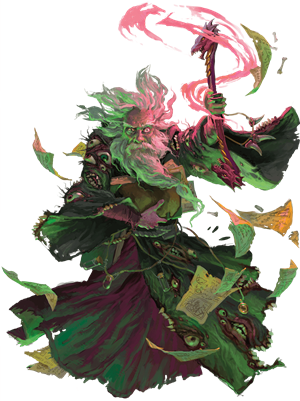 Halaster is described in greatest detail in the Undermountain Overview at the start of Waterdeep: Dungeon of the Mad Mage. In short, he’s a powerful wizard of mysterious origin who was inexplicably driven to create a mighty dungeon. He was driven mad by a knot in the Weave of Magic that was created when an ancient society of elves that once lived in what is now Waterdeep used a grand ritual to remove any trace of their capital city from the world. I like this. This idea has potential, but the players don’t have any chance to learn about it or interact with this history in any way during the adventure. Let’s remember it for later.
Halaster is described in greatest detail in the Undermountain Overview at the start of Waterdeep: Dungeon of the Mad Mage. In short, he’s a powerful wizard of mysterious origin who was inexplicably driven to create a mighty dungeon. He was driven mad by a knot in the Weave of Magic that was created when an ancient society of elves that once lived in what is now Waterdeep used a grand ritual to remove any trace of their capital city from the world. I like this. This idea has potential, but the players don’t have any chance to learn about it or interact with this history in any way during the adventure. Let’s remember it for later.
Halaster constantly appears in some way, shape, or form throughout the dungeon. Oftentimes, it is in the form of enchanted statues, but the characters have an opportunity to meet Halaster—or at least a simulacrum of him—as early as the Level 1 – Dungeon Level. Not to mention, Halaster is always watching. He is practically omniscient within Undermountain, and characters that defeat powerful monsters or otherwise create chaos in the dungeon’s ecosystem will surely draw his attention. As written, Halaster is a fairly neutral presence. He rarely takes action within the dungeon, and may even take on powerful spellcasting characters as his apprentices, if they impress him.
This is for a fairly good reason; if Halaster wanted to kill the characters, it would be easy to simply smite them where they stand the moment they proved to be a threat to him. Instead, Halaster’s madness causes him to vacillate between ire, amusement, and cordiality. This instability allows you to alter Halaster’s mood on a whim, letting you use him as a vicious enemy, a neutral observer, or a potential ally on a level-by-level basis.
The Grand Story
Even making Halaster a fully fleshed-out villain might not be enough, however. Players who have spent an entire campaign in a 23-level dungeon might need a plot more elaborate to feel like the adventure was worth the effort. Here’s one possible storyline you can use to connect the disparate levels of Undermountain into a full adventure. The following story idea is extrapolated from existing Forgotten Realms canon, but takes creative liberties in the process, creating a story that is extremely non-canon, but totally usable in a home game.
Undermountain Origins
Undermountain was created because Halaster was compelled by his own madness to build it, and to continue building it out into eternity. The Mad Mage built his original tower upon the land that would become Waterdeep by an unknown and powerful source of magic. This source was a knot in the Weave of Magic inadvertently created by an ancient elven civilization that sought to transcend reality. Halaster is more than the dungeon’s creator; he is its avatar. Halaster has died countless times, but he always returns before long. It is said that Undermountain cannot exist without Halaster, and his return is necessary to keep the dungeon from being utterly destroyed.
The truth is that the knot in the Weave has gained sentience over its millennia of imprisonment beneath the earth. It compelled Halaster to create Undermountain as a “body” for its restless mind. The being known as Undermountain feeds off of the lives extinguished in its bloodstained halls, and it compels creatures to delve into it in order to feed its hunger for mortal lives. Halaster believes himself to be the master of Undermountain, yet while he is Undermountain’s most powerful denizen, he is also the dungeon’s greatest weakness.
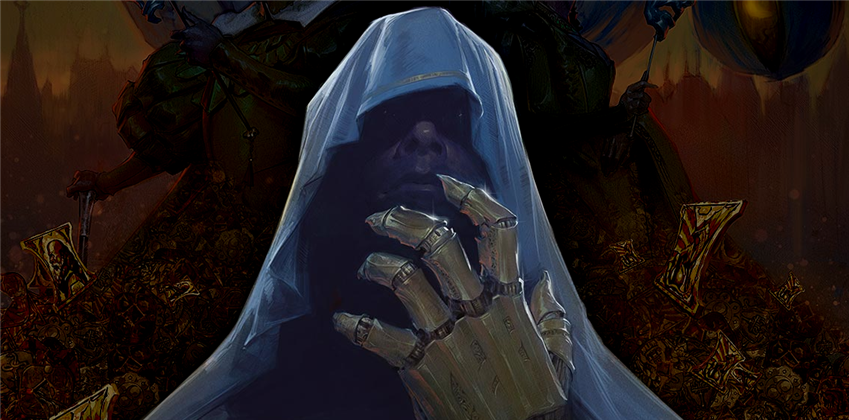
Manshoon’s Greatest Fear
Undermountain has created thousands of clones of Halaster Blackcloak, and sealed them in an icy crypt beneath the Mad Wizard’s lair (using one of the expanded dungeon passages in Level 23). Whenever Halaster’s body is destroyed, the dungeon ensnares his soul and places it into a new body, animating that clone and ensuring Halaster and Undermountain’s continued survival. This precarious plan was threatened by another dark wizard who lived on through countless clones: Manshoon the Manyfaced. Manshoon’s desire to take control of Waterdeep in Waterdeep: Dragon Heist was driven not by ambition, but by fear. This Manshoon is one of the few remaining clones of the original Manshoon; one of the few that survived the arcane cataclysm that ensued when all of Manshoon’s dormant clones were animated at once.
Manshoon had long known that Halaster was a threat to his schemes, but his divinations had recently revealed that Halaster’s countless clones were beginning to stir as the Mad Mage’s grip on sanity grew looser and looser. He feared that the chaos of another Manshoon War—this time instigated by the awakening of an army of Halaster Blackcloaks—would topple his well-laid schemes and perhaps even wipe out life on Faerûn. Not willing to risk the danger, Manshoon entered Undermountain and challenged Blackcloak to a spell duel for control of Undermountain. Halaster, ever-inscrutable, giggled, accepted, and demanded Manshoon bet his left arm against all of Undermountain.
Manshoon lost, and fled the dungeon in disgrace. He constructed an artificial arm and retreated to Waterdeep to take control of Waterdeep and muster a force that could crush Halaster. His efforts to take control of the city are detailed in Waterdeep: Dragon Heist. Meanwhile, Halaster gave Manshoon’s severed arm to the headmaster of Dweomercore as a gift. The Mad Mage treated his encounter with Manshoon as a trivial occurrence, but it caused Undermountain to realize that its master plan could be in danger.
Undermountain’s Master Plan
The greatest dungeon in Faerûn has schemed for centuries. It wants its halls to cover all of Toril, expanding beneath the sea, the Underdark, and across all continents. It wants to drive Halaster past the point of utter madness so that it can assume complete control of the Mad Mage. With Halaster completely under its control, Undermountain can fragment his soul and animate all of the clones it created to exponentially increase the speed of its growth. And once it has claimed all of Toril, perhaps this knot in the Weave could tap into the planet’s ley lines and hijack the entire Weave of Magic. Its long-term goals are beyond human comprehension, but its short-term goal of encircling Toril and hypnotically compelling its inhabitants to enter its depths are malicious enough to warrant immediate action.
Its only weakness is Halaster. Undermountain tries to exert its full control over the Mad Mage to keep him safe from harm, but he is also the dungeon’s greatest tool. It deploys Halaster methodically—but the erratic wizard is not yet under the dungeon’s complete control. His own free will and immense magical power allows him to travel as he wishes, even though Undermountain’s control constantly tugs at his mind.
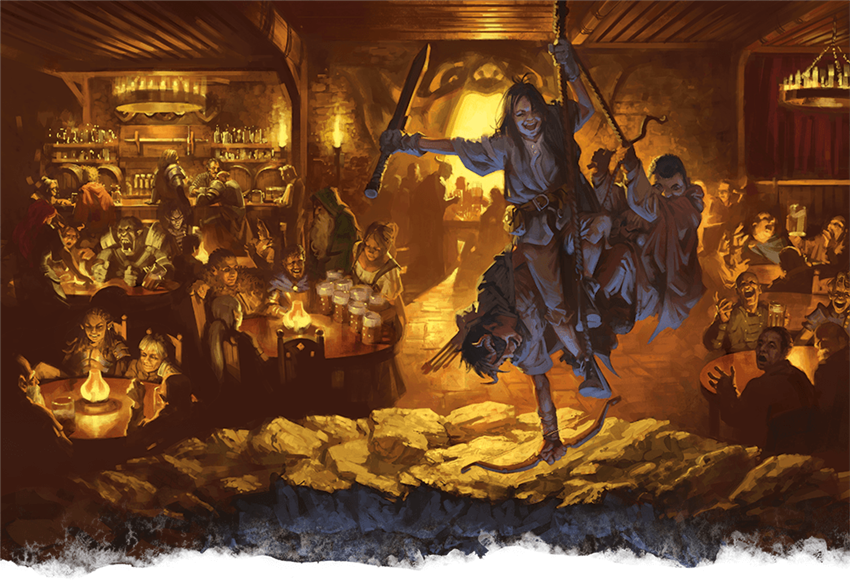
The Undermountain Adventure
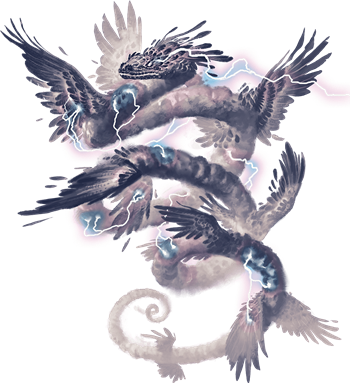 Now we reach the present day. Undermountain grows more powerful as Halaster’s sanity slips. The Mad Mage is practically Undermountain’s puppet, as expressed by his erratic behavior, but some part of Halaster’s threadbare mind knows he is being manipulated. To this end, he uses magic to call the characters into Undermountain. He longs to be confronted and killed in his lair, and he uses Undermountain’s countless traps and monsters to “train” worthy adventurers so that they are powerful enough to destroy him when they finally meet him in battle.
Now we reach the present day. Undermountain grows more powerful as Halaster’s sanity slips. The Mad Mage is practically Undermountain’s puppet, as expressed by his erratic behavior, but some part of Halaster’s threadbare mind knows he is being manipulated. To this end, he uses magic to call the characters into Undermountain. He longs to be confronted and killed in his lair, and he uses Undermountain’s countless traps and monsters to “train” worthy adventurers so that they are powerful enough to destroy him when they finally meet him in battle.
Only a wish spell, cast when Halaster is killed, can trap or destroy his soul and prevent it from being placed in a new clone. If Halaster is truly killed, Undermountain shudders in wrath and the knot in the Weave that bound its power to Undermountain and to Halaster begins to die. Its last furious act of vengeance is an attempt to collapse the dungeon on top of the characters, who must escape from the bottom of Undermountain to its top using the portals littered throughout its halls. If the characters escape the dungeon and you want an even greater “final boss” battle, the knot in the Weave could manifest in Waterdeep—as parts of the city collapse into the earth—by its remaining power to take physical form and try to destroy the characters.
This creature could be an elder tempest with the Spellcasting feature of a lich. For an even more climactic battle, it could use its command of magic to animate a Walking Statue of Waterdeep or two to do its bidding.
Then, with the knot in the Weave destroyed, all who fell under its sway are freed. Durnan still keeps the Yawning Portal open, but now it’s purely out of love for the bar he built, not because he is magically compelled to stay near Undermountain. Halaster’s soul is free to pass into the afterlife. And the thousands of pirates, drow, duergar, aberrations, beasts, and other creatures that were drawn to Undermountain like moths to flame feel a mysterious weight lift from their shoulders. They are free.
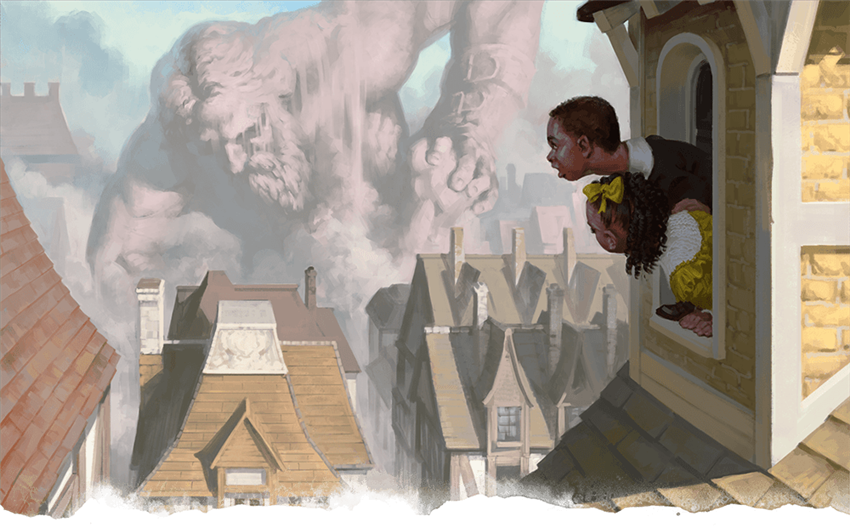
Your Own Undermountain Story
So, what do you think? Was that a bit too far-fetched? Have I been playing too many JRPGs? Would it help keep your players’ attention for 23 dungeon levels? Even if it’s not quite what you want out of Undermountain, I hope it inspired some ideas that you can use to create a dramatic through-line for your Undermountain campaign.
 James Haeck is the lead writer for D&D Beyond, the co-author of Waterdeep: Dragon Heist and the Critical Role Tal'Dorei Campaign Setting, the DM of Worlds Apart, and a freelance writer for Wizards of the Coast, the D&D Adventurers League, and Kobold Press. He lives in Seattle, Washington with his partner Hannah and his corridor critters, Mei and Marzipan. You can usually find him wasting time on Twitter at @jamesjhaeck.
James Haeck is the lead writer for D&D Beyond, the co-author of Waterdeep: Dragon Heist and the Critical Role Tal'Dorei Campaign Setting, the DM of Worlds Apart, and a freelance writer for Wizards of the Coast, the D&D Adventurers League, and Kobold Press. He lives in Seattle, Washington with his partner Hannah and his corridor critters, Mei and Marzipan. You can usually find him wasting time on Twitter at @jamesjhaeck.








-
View User Profile
-
Send Message
Posted Dec 12, 2018@Vitalstatistix I completely agree. I feel like the current DMM is just a bunch of rolls on the DMG dungeon builder. It doesn't tie in to the other Waterdeep book at all, and has little to no character. Good on James Haeck to build out the story here (and according to his Skullport article, attempted to do before publication).
-
View User Profile
-
Send Message
Posted Dec 12, 2018I feel exactly the same way, this is an amazing post.
-
View User Profile
-
Send Message
Posted Dec 13, 2018Great ideas and great write-up! I think I'm going to turn the sentient "knot in the Weave" into a patron for my party's warlock. That'll be fun and sorta messed up.
-
View User Profile
-
Send Message
Posted Dec 14, 2018This is a neat idea, but the "Only a Wish spell can end this" might not be very nice to the PC wizard. This use of the spell seems to fall into the category of uses that gives you the nasty debuff, so having to do a mad dash escape from the dungeon afterwards might be very complicated. Adding in a powerful boss fight on top of that might just make the player wonder if they should participate at all.
-
View User Profile
-
Send Message
Posted Dec 14, 2018On the contrary, I think the tremendous responsibility of hanging on to your most powerful spell and hoping against hope you don't suffer terrible consequences is one of the most dramatic parts of this scenario. Every player is different, though. That's why we adapt these things for our own home game.
-
View User Profile
-
Send Message
Posted Dec 16, 2018I finished playing The Forge of Fury just a month ago and I found that I had a similar problem. What my players found fun was killing the monsters but that was the only fun to be had. We still enjoyed it a lot but having a more deep backstory with the Duergar would have been better. I will be running the first three levels of The Dungeon of The Mad Mage after christmas and I will try to incorporate more of a story like you talk about in the article. Great Job!
-
View User Profile
-
Send Message
Posted Dec 20, 2018This is strangely similar to what I had planned for my campaign of DotMM
-
View User Profile
-
Send Message
Posted Dec 20, 2018What an epic idea! The stated goals that came with the adventure did not seem to bring enough of a plot line for me. your idea is fantastic. I love it. Thanks for the article.
-
View User Profile
-
Send Message
Posted Dec 25, 2018Read again, he is becoming controlled by the knot through his madness. His concient side wants a players strong enough to kill him to finish the madness.
-
View User Profile
-
Send Message
Posted Dec 26, 2018That's not what the comment I replied to was saying.
Having to quote to reply is such a stupid system
If I hit reply TO A COMMENT it should track that. Ugh.
Anyway, fixed now for clarity
-
View User Profile
-
Send Message
Posted Dec 27, 2018This Article saved my campaign, James. Thanks.
-
View User Profile
-
Send Message
Posted Dec 27, 2018I just got Dungeon of the Mad Mage for Christmas, and I really really love this idea of how to flesh out Halaster. I'm excited to put the ideas into practice and see how it works out. Thanks!
-
View User Profile
-
Send Message
Posted Dec 28, 2018Here's a twist for the second idea: Halaster, the real Halaster, awaits the players at the end of floor 23, he sits motionless and catatonic in a chair, dramatically illuminated under a beam of light in an otherwise dark room. His mind is gone, but he lives on. The enemy that has threatened them all this time is not a threat at all. He is only this frail old man, harmless. His interactions and those of Jhesiyra are shadows cast by the living dungeon. It uses these images imprinted upon it to manipulate the PCs. It wants their essence to fatten up and grow stronger-- it intends to eat their essence as it has Jhesiyra and Halaster. When they discover the terrible truth of Undermountain, it intends to eat them, prompting the "final boss". No one is cured from its madness and corruption with its defeat and the players feel it's poisonous influence pulling on their souls, even when it is firmly defeated.
-
View User Profile
-
Send Message
Posted Jan 4, 2019I like it brother. I may use parts of it. I’m thinking maybe that the centuries of dying would have long since driven him paste any vestige of sanity. In fact, and this is just freedorm typing on my iPhone, I’m thinking whomever the mad mage was is long gone. Perhaps undermountain is on the edge of ascendency or even past the edge and and nearing true goddom. Of course that gets a little complicated. It could be using the mad mage avatar as a way to disguise its prescience in order to keep from drawing the notice of the current pantheon. ... hmmmn I’m starting to really warm up to this plot. Go big or go home right? Thanks for the post man.
-
View User Profile
-
Send Message
Posted Jan 6, 2019I like the idea of the dungeon gaining a form of sentience. It could mean that the players become under its sway and unable to venture away from it and perhaps have other curse like effects. The quest could become not just a journey of stopping Halaster but a desire to cure their condition.
-
View User Profile
-
Send Message
Posted Feb 17, 2019I have to say, most of this I like quite a bit. I'd shy away, personally, from giving the players an opportunity to PERMANENTLY undo Undermountain, and Halaster Blackcloak, if only because I'm nostalgic for older Forgotten Realms lore, and would hate to see another part of the past disappear. I might tweak it so Halaster wants to do these things; HE wants to engulf all of Toril, and the players want to stop his army of archmage clones, needing to descend into the depths of Undermountain, and maybe even hunt down the Knot, themselves, knowing that if they don't, Halaster will simply return, again, and again. Maybe they wouldn't even need to fight him, if they can find the Knot, and be rid of it. They could leave him without the safety net, but still intact, for other people to interact with; just not in a way where he can always return.
I'll re-read this a few more times. Dungeon of the Mad Mage is hopefully going to be my next campaign, after my players pass through Curse of Strahd (which I think they are approaching the end of), and I have been trying to figure out how best to keep the party inside, rather than be something fun to do, before going off on another campaign. Such ideas are very much appreciated. Thanks!!!
-
View User Profile
-
Send Message
Posted Mar 13, 2019Just wanted to mention that I like this idea. I'm going to spice it up with a little bit Legend of Grimrock and some other things but yes, going to use it in my game.
-
View User Profile
-
Send Message
Posted Apr 2, 2019This honestly sounds really cool and I think I might use this story. However, I think that I might replace the knot in the weave with a spirit driven mad by, and confined to the knot and has harnessed its power to madden Halastar.
-
View User Profile
-
Send Message
Posted Apr 2, 2019What if during a part of dragon heist, you introduce a certain problem with know explination but tied to magic (people getting mortally sick for instance), that has been happening for a long time, and then when the weave knot is killed, that effect goes away.
-
View User Profile
-
Send Message
Posted Apr 30, 2019I loved it. It was great. I can't wait to do this with my players!